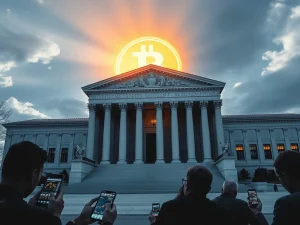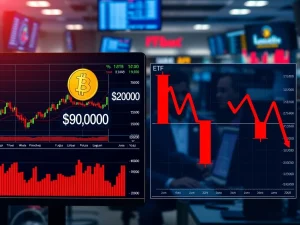Unveiling the Crucial Truth: Why Inflation Erodes Your Purchasing Power Annually

Have you ever noticed your hard-earned money buys less each year? This isn’t just bad luck. Instead, it’s a fundamental aspect of modern monetary systems. This phenomenon, known as inflation, significantly impacts everyone. It particularly affects those in the cryptocurrency space, who often seek alternatives to traditional finance. Understanding why currencies lose value is crucial for safeguarding your wealth.
Understanding Inflation: Why Your Fiat Currency Loses Value
Inflation represents the rate at which the general level of prices for goods and services is rising. Consequently, the purchasing power of currency falls. A $100 bill, which once covered dinner, a movie, and drinks, might now barely afford the meal alone. This consistent decline in value is a built-in feature of modern economies. Governments often aim for a small amount of inflation, believing it stimulates economic growth. However, its long-term effect is clear: your money simply buys less over time.
Many factors contribute to this erosion of value. Firstly, an increase in the money supply without a corresponding increase in goods and services can lead to inflation. Secondly, higher demand outstripping supply also pushes prices up. Ultimately, understanding these dynamics helps explain why your financial resources diminish in real terms each year.
From Bretton Woods to Fiat: A Historical Perspective on Purchasing Power
The story of declining purchasing power has deep historical roots. It notably begins in 1944 with the Bretton Woods agreement. Under this landmark accord, the US dollar was firmly tied to gold at a fixed rate of $35 per ounce. This link provided a stable foundation for global currencies. Other major currencies were then pegged to the dollar, creating a system of fixed exchange rates. This arrangement aimed to prevent the economic volatility seen in previous decades.
However, this gold standard era concluded abruptly in 1971. President Nixon announced the United States would no longer convert dollars to gold at a fixed value. This event, dubbed the “Nixon Shock,” severed the dollar’s last tie to a tangible asset. Consequently, the dollar—and every major currency globally—transformed into pure fiat currency. Fiat money is not backed by a physical commodity like gold or silver. Instead, its value derives solely from government decree and public trust. Since that pivotal moment, the dollar’s purchasing power has steadily declined. A dollar from 1971 now requires more than seven dollars to buy the same goods and services today. This stark difference highlights the significant devaluation over five decades.
Beyond Money Printing: Other Drivers of Inflation
While changes in monetary policy, like the shift to pure fiat currency, are significant, they are not the sole drivers of inflation. Many other economic forces also contribute to the persistent rise in prices. For instance, global energy shocks can dramatically increase costs across all sectors. When oil prices surge, transportation becomes more expensive, impacting manufacturing and distribution. This cost increase inevitably filters down to consumers.
Furthermore, supply chain disruptions play a critical role. Events like natural disasters, pandemics, or geopolitical conflicts can interrupt the flow of goods. This scarcity then drives prices higher. Consider the impact on everyday items when key components cannot reach factories. Similarly, rising wages can also push prices up. As labor costs increase, businesses often pass these expenses onto consumers through higher prices for their products or services. While central banks frequently state that inflation around 2% is “healthy” for economic growth, the cumulative effect of these various drivers, alongside monetary expansion, consistently devalues your money. This constant erosion directly impacts your long-term purchasing power.
Bitcoin and Gold: Alternatives in an Era of Declining Fiat Currency
The persistent decline in the purchasing power of fiat currencies naturally raises a crucial question: What does this mean for savers? Many individuals seek ways to protect their wealth from inflation’s corrosive effects. Historically, gold has served as a primary hedge against currency devaluation. Gold possesses inherent scarcity; its supply is limited by mining capacity. This characteristic makes it a reliable store of value for many investors.
In the digital age, Bitcoin has emerged as a compelling modern alternative. Like gold, Bitcoin is fundamentally scarce. Its supply is capped at 21 million coins, a limit enforced by its protocol. This fixed supply contrasts sharply with fiat currencies, which central banks can print in potentially unlimited quantities. Proponents argue that Bitcoin’s predictable and limited supply makes it an ideal hedge against inflation. It offers a decentralized form of money, free from government control and manipulation. Consequently, many view Bitcoin as “digital gold.”
However, the debate continues. Some economists caution that without a flexible money supply, economies could struggle to manage debt or respond effectively to crises. They argue that a system reliant solely on scarce assets like gold or Bitcoin might lack the adaptability needed for modern economic complexities. Nevertheless, for those concerned about the long-term viability of fiat money, both gold and Bitcoin offer distinct avenues for wealth preservation.
Safeguarding Your Savings: Strategies Against Inflation
Protecting your savings from the relentless march of inflation requires thoughtful planning. Understanding the mechanisms behind currency devaluation is the first step. For many, diversifying assets beyond traditional bank accounts and fiat holdings becomes a priority. This strategy often includes investments in assets known for their scarcity, such as real estate, commodities, and, increasingly, digital assets like Bitcoin. These assets tend to retain or even increase their value during inflationary periods.
Moreover, staying informed about economic policies and central bank actions is vital. These decisions directly influence the future value of your money. Education on financial markets and alternative investment strategies empowers individuals to make informed choices. The ongoing discussion around the stability of fiat currency versus the potential of decentralized alternatives like Bitcoin highlights a critical shift in how people view wealth preservation. Exploring resources that delve deeper into monetary history, the risks of runaway inflation, and various wealth protection strategies can significantly benefit your financial future.
The reality of declining purchasing power is undeniable. From the historical shift away from the Bretton Woods system to the current era of pure fiat currency, inflation remains a constant economic force. However, understanding this phenomenon allows you to consider alternatives. Assets like gold and Bitcoin offer potential solutions for those seeking to protect their wealth. Making informed decisions today will undoubtedly help safeguard your financial future against the steady erosion of value.









